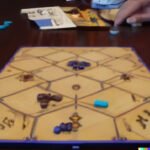If you’re a fan of board games and strategic gameplay, then Root Board Game Faction Strategy is sure to pique your interest. In this article, we will delve into the intricate world of Root Board Game and explore the diverse factions, mechanics, and tactics that make it a thrilling experience for players.
Whether you’re new to the game or a seasoned player looking to enhance your strategy, this article aims to provide valuable insights and tips to help you master faction play.
Root Board Game is known for its unique asymmetrical gameplay, where each player takes on the role of a different faction with its own abilities and objectives. Understanding the dynamics of these factions is essential for developing effective strategies and gaining an edge over your opponents. In this introduction, we’ll lay the foundation for exploring the complexities of faction strategy in Root Board Game, setting the stage for in-depth analysis and practical tips.
Throughout this article, we will examine the strategic aspect of each faction, providing insights into their strengths, weaknesses, and unique playstyles. By understanding these nuances, players can tailor their approach to suit their chosen faction while also anticipating the strategies employed by rival factions. From resource management to forming alliances and engaging in conflict, mastering faction strategy in Root Board Game requires a multifaceted approach that we will thoroughly explore in subsequent sections.
Understanding the Different Factions in Root Board Game
In the Root board game, players can choose from a variety of factions, each with its own unique abilities, strengths, and weaknesses. Understanding the different factions is crucial to developing a successful strategy in the game. Here’s an overview of the factions in Root:
- Marquise de Cat – This faction focuses on establishing and maintaining control over key locations on the board. With strong military power and the ability to spread their influence quickly, they are often seen as an aggressive faction.
- Eyrie Dynasties – The Eyrie faction operates like a government in exile striving to reclaim their lost power. Players must carefully manage their leaders and deal with constant internal politics to avoid collapsing.
- Woodland Alliance – As a guerilla warfare-based faction, the Woodland Alliance thrives on stirring up revolts and gathering supporters to overthrow their rivals. They rely on asymmetrical warfare tactics to win the game.
- Vagabond – The Vagabond operates independently, forging alliances and completing quests for victory points. They have significantly different playstyle compared to other more direct combat-oriented factions.
Understanding how each faction operates is crucial for developing a winning strategy. By knowing each faction’s unique abilities and playstyle, players can adapt their own strategy accordingly.
Another important aspect of understanding the different factions in Root board game is recognizing how they interact with each other on the board. Each faction has its own goals and incentives which can lead to shifting alliances, backstabbing, or forming coalitions against common enemies.
Players should take into account how their chosen faction aligns with or opposes other factions in order to make strategic decisions that will benefit them in the long run. Developing this level of understanding can elevate gameplay by allowing players to anticipate opponents’ moves and adapt their strategies accordingly.
Overview of the Gameplay and Mechanics
The gameplay and mechanics of Root Board Game are essential components that players must understand to excel in faction strategy. The game is set in a woodland forest, with each player taking on the role of a different faction, including the Marquise de Cat, the Eyrie Dynasties, the Woodland Alliance, and the Vagabond. Each faction has its unique abilities, objectives, and playstyle, making it crucial for players to familiarize themselves with the intricacies of each.
To navigate through the gameplay and mechanics of Root Board Game, players should consider the following key points:
- Understand Your Faction: Take the time to thoroughly comprehend the strengths, weaknesses, and playstyle of your chosen faction. Each faction excels in specific areas and has different victory conditions.
- Adapt to Changing Dynamics: The game’s dynamic board state requires players to be flexible and adaptive. Be prepared to adjust your strategy based on your opponents’ actions and the evolving landscape of the game.
- Utilize Action Economy: Efficiently managing your limited actions each turn is vital for success. Prioritize actions that align with your faction’s strengths and objectives.
Mastery of the gameplay and mechanics not only enhances a player’s understanding of their own faction but also enables them to anticipate and respond effectively to their opponents’ strategies. By incorporating these principles into their gameplay, players can elevate their overall faction strategy and increase their chances of success in Root Board Game.
Analyzing the Strategic Aspect of Each Faction
Root Board Game Faction Strategy is all about understanding the unique strategic aspects of each faction in the game. Each faction comes with its own strengths, weaknesses, and special abilities that require a different approach to achieve victory. In this section, we will delve into a detailed analysis of the strategic aspect of each faction in the Root Board Game.
The Marquise De Cat
The Marquise de Cat faction is focused on building and maintaining their dominance over the forest. Their strategy revolves around establishing control through buildings and warriors while managing their wood and military forces efficiently. Understanding how to expand their rule without spreading themselves too thin is crucial for success with this faction.
The Eyrie Dynasties
The Eyrie Dynasties faction is characterized by its strict adherence to a set of laws and decrees that dictate their actions. Their strategic aspect lies in balancing expansion, maintaining control, and avoiding turmoil within their ranks. Players must carefully plan their actions to avoid an uprising within the Eyrie Dynasties’ ranks while extending their influence across the woodland.
The Woodland Alliance
The Woodland Alliance faction relies on inciting uprisings and rallying supporters to challenge the ruling factions. Their strategic aspect involves building sympathy among creatures in the forest and inciting revolts against oppressors. Understanding when to launch attacks and when to bide their time is crucial for players using the Woodland Alliance faction.
Understanding these strategic aspects is essential for players looking to master Faction Strategy in Root Board Game. Each faction offers a distinct gameplay experience, requiring different tactics and approaches for success. By analyzing and understanding these aspects, players can develop effective strategies tailored to their chosen faction’s strengths which are essential for achieving victory in the game.
Tips and Tactics for Mastering Faction Strategy
Understanding Your Faction’s Strengths and Weaknesses
One of the most crucial tips for mastering faction strategy in Root Board Game is understanding the unique strengths and weaknesses of your chosen faction. Each faction has its own abilities, resources, and playstyle, so it is important to capitalize on these strengths while also finding ways to mitigate any weaknesses.
For example, the Marquise de Cat excels at building and controlling clearings, while the Eyrie Dynasty relies on fulfilling their Decree cards to maintain power. By understanding these differences, players can tailor their strategies accordingly.
Adapting to Changing Conditions
Another key tactic for mastering faction strategy is the ability to adapt to changing game conditions. With various factions interacting on the board and vying for control, it is essential for players to be flexible in their approach. This may involve re-evaluating your initial plans based on opponents’ actions, shifting alliances as needed, or even changing your overall strategy mid-game. Adapting to the ebb and flow of gameplay will ultimately lead to success in Root Board Game.
Developing Long-Term Goals
Finally, a successful faction strategy in Root Board Game involves developing long-term goals that align with your faction’s capabilities. Whether it’s establishing a strong presence on the board, maintaining a steady flow of resources, or achieving specific objectives related to victory points, having a clear vision of your endgame can guide your decisions throughout play.
By setting long-term goals and working towards them strategically, players can ensure that their faction remains competitive and influential throughout the game.
Discussing the Importance of Resource Management in the Game
Resource management is a crucial aspect of the Root board game faction strategy. Each faction in the game has its own unique resources, such as warriors, buildings, and special abilities, which must be carefully managed in order to succeed. Proper allocation and utilization of these resources can make the difference between victory and defeat.
One key resource in the game is warriors, which are essential for expanding your faction’s presence on the board and defending against enemy attacks. It is important to balance the use of warriors for both offensive and defensive purposes, as overcommitting to one strategy can leave you vulnerable in other areas of the game.
In addition, managing your faction’s buildings effectively is vital for generating resources and unlocking powerful abilities that can give you an edge over your opponents.
Another critical aspect of resource management in Root is managing your hand of cards. Players must carefully consider when to play their cards for maximum impact while also ensuring they have enough cards left in their hand to respond to their opponents’ actions. Neglecting this aspect of resource management can leave a player at a significant disadvantage, so it’s important to plan ahead and manage your hand wisely.
Effective resource management is not only about using your own resources efficiently but also about disrupting your opponents’ plans by denying them access to key resources or forcing them to expend valuable assets. Understanding how to manipulate the flow of resources in the game is a key skill that can elevate your faction strategy and help lead you to victory.
| Resource | Importance |
|---|---|
| Warriors | Essential for expansion and defense |
| Buildings | Generate resources and unlock powerful abilities |
| Cards | Strategic use can provide a significant advantage |
Exploring the Role of Alliances and Conflict in Faction Strategy
In the Root board game, faction strategy revolves not only around individual player actions but also on how they navigate alliances and conflicts with other factions. The game’s dynamic nature allows for shifting allegiances and strategic betrayals that can greatly impact a faction’s success or downfall.
Alliances in Root can provide crucial advantages, such as shared territories or resources, as well as protection from common enemies. Forming alliances requires careful negotiation and understanding of other players’ intentions. On the other hand, conflicts arise when factions have opposing goals or when one faction feels threatened by the expansion of another. Combat is an integral part of the game and mastering conflict resolution is key to achieving victory.
The role of alliances and conflicts in faction strategy adds a layer of complexity to the game, requiring players to constantly evaluate their relationships with other factions. Whether it’s forming temporary truces to achieve mutual objectives or engaging in calculated battles for territorial dominance, understanding the dynamics of alliances and conflicts is essential for success in Root board game faction strategy.
| Root Board Game Faction Strategy | Alliances and Conflicts |
|---|---|
| Importance | The role of alliances and conflicts adds complexity to faction strategy |
| Strategy | Players must evaluate relationships for success |
| Tactics | Negotiation, conflict resolution, and combat are crucial skills |
Real-Life Examples and Case Studies of Successful Faction Strategies
The Root board game offers an immersive and strategic experience, allowing players to take on the role of different factions vying for control of the Woodland. As players navigate through this territory, they must develop and execute a successful faction strategy to emerge victorious.
In this section, we will delve into real-life examples and case studies of successful faction strategies in the Root board game, showcasing how players have effectively utilized their chosen faction’s unique abilities to secure dominance.
One notable example of a successful faction strategy in Root is the Marquise de Cat, known for its focus on building and maintaining its dominance through its supply lines. The Marquise de Cat strategically places workshops and sawmills to establish a strong infrastructure while leveraging warriors to fend off opponents. By effectively managing resources and controlling key areas of the map, players have demonstrated how the Marquise de Cat can secure victory through a calculated expansionist approach.
Another compelling case study involves the Eyrie Dynasties, which presents an intriguing challenge due to its requirement to fulfill specific decrees each turn. Successful players have showcased their ability to carefully plan and execute their actions, ensuring that they maintain momentum with their decrees while expanding their influence across the Woodland. This faction’s dynamic playstyle demands adaptability and foresight, making it a fascinating subject for analyzing successful faction strategies in the Root board game.
Lastly, the Vagabond stands out as a unique faction that offers versatile gameplay options. This individualistic character requires strategic navigation of relationships with other factions while constantly scavenging for items and quests. Real-life examples illustrate how players have adeptly balanced opportunistic actions with diplomatic maneuvers, demonstrating that successful faction strategies encompass not only resource management but also player interaction dynamics in the Root board game.
Conclusion and Final Thoughts on Mastering Faction Strategy in Root Board Game
In conclusion, mastering faction strategy in the Root board game requires a deep understanding of the unique abilities and goals of each faction. Players must carefully analyze the strengths and weaknesses of their chosen faction and develop a strategic approach that suits their playstyle. It’s crucial to remember that there is no one-size-fits-all strategy, as each faction offers a different experience and requires adaptation to the ever-changing dynamics of the game.
Resource management is a key aspect of successful faction strategy in Root. Balancing the acquisition and allocation of resources is essential for maintaining stability and growth within your faction. Learning when to invest in building, recruiting, or expanding your reach can make the difference between victory and defeat.
Alliances and conflict also play a significant role in faction strategy. Players must navigate complex interactions with other factions, negotiating temporary truces or forming strategic partnerships while remaining mindful of their own long-term objectives. Ultimately, successful faction strategy hinges on flexibility, adaptability, and a deep understanding of both your own faction’s abilities and those of your rivals. With practice and perseverance, mastering faction strategy in Root board game can lead to thrilling victories and memorable experiences for players.
Frequently Asked Questions
How Do You Win at Root?
Winning at Root requires a deep understanding of the asymmetrical factions and their unique abilities. It involves strategic decision-making, knowing when to exploit weaknesses and when to form alliances in order to achieve victory.
Is Root a Strategy Game?
Yes, Root is definitely a strategy game. Players need to carefully plan their moves, anticipate opponents’ actions, and strategize based on their faction’s strengths and weaknesses. The game involves thoughtful decision-making and long-term planning.
Is Root Board Game Complex?
Root can be considered complex due to its asymmetrical gameplay, where each faction has its own rules and abilities. This complexity adds depth to the game but may also require additional time for players to fully grasp the intricacies of each faction’s mechanics.

I love playing all kinds of games – from classics like Monopoly to modern favourites like Ticket to Ride.
I created this blog as a way to share my love of board games with others, and provide information on the latest releases and news in the industry.





